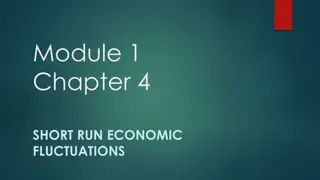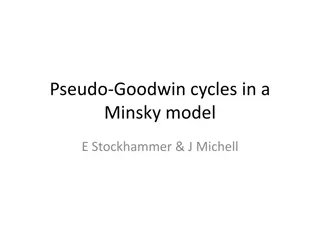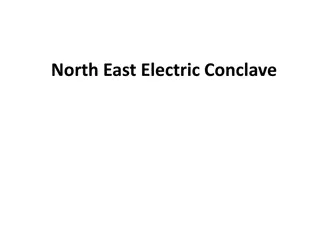Understanding Trade Cycles and Economic Fluctuations
A trade cycle refers to the recurrent fluctuations in economic activities such as employment, output, income, prices, and profits. The cycle includes phases of prosperity, depression, recovery, and recession. These cycles are characterized by synchronicity, asymmetry, and international impact. Understanding the phases of the trade cycle can help in predicting economic trends and planning for the future.
Download Presentation

Please find below an Image/Link to download the presentation.
The content on the website is provided AS IS for your information and personal use only. It may not be sold, licensed, or shared on other websites without obtaining consent from the author. Download presentation by click this link. If you encounter any issues during the download, it is possible that the publisher has removed the file from their server.
E N D
Presentation Transcript
Trade Cycles This Photo by Unknown Author is licensed under CC BY
A trade cycle refers to fluctuations in economic activities specially in employment, output and income, prices, profits etc. According to Keynes, A trade cycle is composed of periods of good trade characterised by rising prices and low unemployment percentages altering with periods of bad trade characterised by falling prices and high unemployment percentages . Features of a Trade Cycle: 1. A business cycle is synchronic. When cyclical fluctuations start in one sector it spreads to other sectors.
2. In a trade cycle, a period of prosperity is followed by a period of depression. Hence trade cycle is a wave like movement. 3. Business cycle is recurrent and rhythmic; prosperity is followed by depression and vice versa. 4. A trade cycle is cumulative and self-reinforcing. Each phase feeds on itself and creates further movement in the same direction. 5. A trade cycle is asymmetrical. The prosperity phase is slow and gradual and the phase of depression is rapid.
6. The business cycle is not periodical. Some trade cycles last for three or four years, while others last for six or eight or even more years. 7. The impact of a trade cycle is differential. It affects different industries in different ways. 8. A trade cycle is international in character. Through international trade, booms and depressions in one country are passed to other countries. Phases of a Trade Cycle: Generally, a trade cycle is composed of four phases depression, recovery, prosperity and recession.
Depression: During depression, the level of economic activity is extremely low. Real income production, employment, prices, profit etc. are falling. There are idle resources. Price is low leading to a fall in profit, interest and wages. All the sections of the people suffer. During this phase, there will be pessimism leading to closing down of business firms. Recovery: Recovery denotes the turning point of business cycle form depression to prosperity. In this phase, there is a slow rise in output, employment, income and price. Demand for
commodities go up. There is increase in investment, bank loans and advances. Pessimism gives way to optimism. The process of revival and recovery becomes cumulative and leads to prosperity. Prosperity: It is a state of affairs in which real income and employment are high. There are no idle resources. There is no wastage of materials. There is rise in wages, prices, profits and interest. Demand for bank loans increases. There is optimism everywhere. There is a general uptrend in business community.
However, these boom conditions cannot last long because the forces of expansion are very weak. There are bottlenecks and shortages. There may be scarcity of labour, raw material and other factors of production. Banks may stop their loans. These conditions lead to recession. Recession: When the entrepreneurs realize their mistakes, they reduce investment, employment and production. Then fall in employment leads to fall in income, expenditure, prices and profits. Optimism gives way to pessimism. Banks reduce their loans and advances. Business expansion stops. This state of recession ends in depression.
Control of Trade Cycles In modern times, a programme of economic stabilization is usually directed towards the attainment of three objectives: Controlling or moderating cyclical fluctuations, Encouraging and sustaining economic growth at full employment level, and Maintaining the value of money through price stabilization. Thus, the goal of economic stability can be easily resolved into the twin objectives of sustained full employment and the achievement of a degree of price stability.
A trade cycle cannot be controlled by a single operation. Following instruments are used to attain the objectives of economic stabilization, particularly for the control of trade cycles, relative price stability and attainment of economic growth: Monetary policy, Fiscal policy, Anti-cyclical budgeting, and Automatic stabilizer (or) Built-in stabilizer.
1. Monetary policy to control trade cycle Monetary factors aggravate the operation of trade cycle. Monetary inflation, leading to higher income and profits, strengthens the boom conditions. Similarly, monetary deflation reinforces the downswing in the economic activities leading to depression. So, the monetary policy should be adopted in an anti-cyclical way. During the period of upswing and boom, supply of money and credit should be controlled and regulated. The central bank of the country should adopt all or chosen methods of credit control. The weapons of credit
control, such as bank rate, open market operations, reserve ratio, etc. should be utilized and to control inflationary tendencies and over- expansion of business activity. In times of depression or signs of recession, expansionary, credit policy should be adopted to mitigate the severity of recession and depression. Monetary policy alone may not be sufficient to check the instability created by business cycle. It should be reinforced with suitable fiscal policy. 2. Fiscal policy. Keynes and others have recommended compensatory finance or compensatory fiscal policy to bring about stabilization of business activity. The three main instruments of fiscal policy are:
taxation, spending, and borrowing.. These three instruments have to be effectively utilized to control the severity of boom or the difficulties of depression. During the periods of recession and depression, the government should reduce substantially the taxes and leave more money in the pockets of individuals for spending and investment. The government should stimulate economic activity by initiating public works project. In time of boom, the
government should try to mop up extra or the surplus money through attractive borrowing schemes. 3. Anti-cyclical budgeting The budgetary policy of the government should be in tune with the measures already indicated to combat the instability created by business cycle. During times of depression, a policy of deficit budgeting should be adopted. This will increase the flow of income in the economy. During upswing, surplus budgeting should be adopted. Thus, the budgeting should be done in anti-cyclical method.
4. Automatic stabilizer or Built-in-stabiliser When fluctuations take place in the economy, the available monetary and fiscal tools cannot be geared quickly to set right the imbalance. Further it is also too much to expect the government officials to act quickly to the tempo of change in economic activity; So the policy makers make provisions for automatic adjustments in the fiscal structure. These built-in- stabilisers or automatic stabilizers will automatically come into play in proportion to the rise and fall of economic activity. By this method, the tax rates are so fixed that in the upward phase of the trade cycle, with increase in national income, the
tax yield will go up automatically at a faster rate without any change in the tax structure. The progressive rate of taxation is one of the important built-in-stabiliser in the tax structure. Another important built-in-stabiliser is the unemployment insurance scheme. During periods of prosperity or upswing, the employers pay taxes and the employees pay some amount towards unemployment insurance scheme. This money gets accumulated. During times of depression and the consequent unemployment, the public spending is automatically effected by doling out money to the unemployed people. Thus, the
flow of money is regulated automatically from the people to the government in times of prosperity, and from government to the people in times of adversity. The built-in-stabilisers play a strategic role in fighting recessions.























